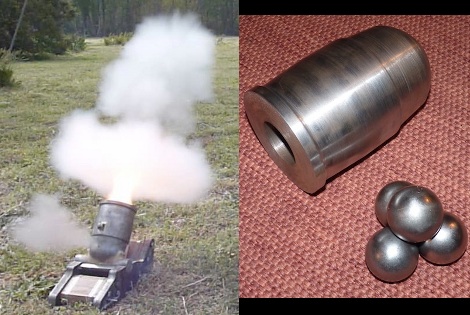
[Sir Keyboard Commando] just emerged from his machine shop to show off the 1/6th scale model of a Civil War mortar which he recently finished fabricating. It started with some bar stock that measured four inches in diameter and accepts steel balls the size of golf balls as ammunition.
The bore diameter is 1.725″ which gives just a bit of clearance for the 1.685″ golf ball specs. Each of the steel balls weighs in at just over 11 ounces. You get a really good look at the finished mortar in this test-fire video. It’s quite small but [Sir Keyboard Commando] reports that the full assembled unit still weighs in at a whopping forty pounds.
This certainly isn’t an improvised weapon, but we’re quite surprised to see it being test fired. We’d bet it turns some heads that the local firing range.
[via Reddit]
















Dude, I have seen the exact same thing last night on History Channel (Pawn Stars) and it was shooting out bowling balls :)
This is great :)
That’s incredible. Next step: high explosive rounds.
3rd step: Club Fed.
HE rounds require a 200usd tax stamp per round, and the required licencing from BATFE for their manufacture.
Is it per round or just for the stamp? Per round doesn’t sound right.
Per round.
In europe you can get 25 years for that.
Thankfully I don’t live in Europe.
Hah! I open up Hackaday and lo and behold my mortar is on here!
It’s perfectly safe to fire because it follows all the safety rules of thumb reenactment groups specify. 1:1 wall thickness to powder chamber at the breech, tough metal that doesn’t easily work harden, proper windage between projectile and bore, and sensible charges.
I’m not going to claim it can’t blow up, but it’s not going to blow up without some work.
<=.37mm rounds with <.5 ounce of explosives and <4 ounces of propellant are not regulated
Anything larger in size, payload, or propellant needs a tax stamp for EVERY round. So $cost+$200 every time you pull the trigger.
And ATF wants the pieces so they can finish the paperwork.
Beautiful work, and then he paints it all black?! Why? Oh why?
It’s a replica. Real gun bluing agent is expensive. It would cost several hundred dollars for the fake stuff, closer to a thousand for the real hot process.
The alternative is paint.
It’s painted mainly because it would have been painted black in the Civil War.
Close. The Rodman mortars which were made in their Cold Spring NY based foundry were made from a steel formulation which just happened to be that color. They made the best guns for the Union Army during the entire period. And I’m only stating that because I definitely recall reading the reports from the period via American History.
Actually Rodman never made any mortars. He focused on strengthening large columbiads via his hollow cast, water cooled method. Some (all?) of the 13″ seacoast mortars were hollow cast and water cooled, but they would have been painted. Check out the 1861 Ordinance Instructions and there are chapters devoted to preserving metal.
the paint on the steel makes sense, but the wood looked great prior to paint. the bondo is what made me go: “Why? Oh why?”
that thing is great btw
Very good!
That’s some impressive windage!
You could build a pneumatic cannon that would easily exceed the power, accuracy and range of this gun from common hardware store parts. Can’t stop the signal!
WTF are Grains? is that another of you weired imperial units?
When will you switch over to Metric System?
Only US, Liberia and Burma are using it….
Grains is a measurement used all over the world Tom if you bothered to Google…because even half a gram of gunpowder would exceed several SAAMI recommended loads in many calibers of firearms. Some of them to the point of destroying the firearm it would be used in.
Grains are the standard unit of measurement for bullets and gunpowder practically everywhere in the world, even down here in Aus where we use the metric system.
Oh, I did google that… But a “7000th of a Pound” is not quite based on a natural constant ;)
But ok, I’ll stop trolling… I see it’s just still common to use it for Ammunition… Although mg is much more easy to calculate with
Now there’s a hacker with big steel balls, and a mortar to fire them from! This is very impressive work, and not an arduino in sight, even more impressive, and while the paint job does make it look authentic I wish he had left the wood natural, but hey its still a blast.
Hey! Kid! GET OFF OF MY LAWN!
Want. Please put a kit together for sale.
Little mortar projects always rock. But remember it’s very easy to put your face over one of those things.
I wonder why nobody ever invents a cannon that uses steam?
(hint hint)